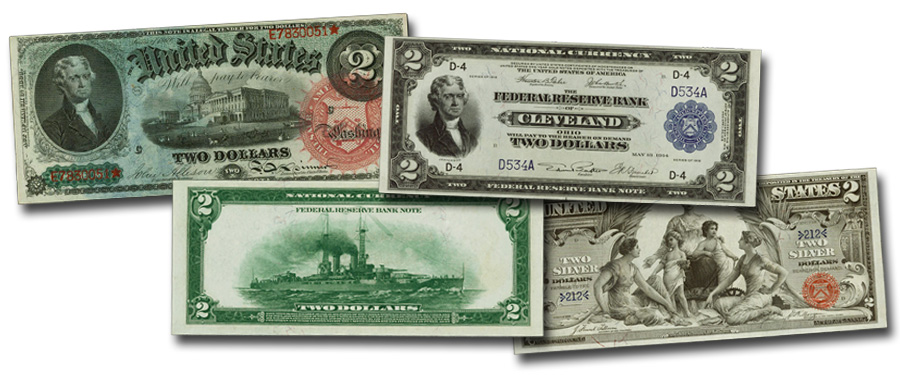
Looking for a new direction for your collection? Do you appreciate both the artistic beauty and historic background that the notes in our hobby offer? Let me make a suggestion for a new collection. Try assembling a large size $2 type set. In this week’s article and next week’s, we will offer suggestions for assembling such a collection.
Many of our hobby’s most popular notes are of the $2 denomination. During their time many people considered $2 bills to be unlucky (hence all the missing corners), but these notes are highly desirable in the modern rare currency market.
Depending on what you count as individual types, the set encompasses roughly 10 to 12 notes. Including different series dates, seal types, and back designs will run the count north of 20 notes but will give you a diverse range of seal sizes and colors as well as differing serial number colors. If you have the means and the patience, I suggest going this route. For the purpose of this exercise I will look at two grade ranges, mid-grade Very Fine 30 and, for the advanced collector, Gem Uncirculated 65. Values assume notes are major third-party graded, non-net/apparent, and Gem with EPQ or PPQ designation.
You may choose to buy notes in any order you like, making the most of an opportunity when it arises. I will go in type order from earliest to latest, beginning with a one note type, the Fr. 41 1862 Legal Tender Note. This is the first of a long running tradition of $2 notes featuring Thomas Jefferson. Nice examples feature great color with vibrant green design elements and cherry red seal and serial number. Overprints differ in quality. Pick one with a boldly printed seal. A nice VF 30 will cost you about $1,000 to $1,200. A Gem 65 note here is a tall order and will cost around $20,000. A Choice 64 note may be the better option for around $7,000.
The next note in the set is easily one of the most popular and, if you find a nice example, arguably the prettiest note in the set. Fr. 69, another one note type, is the 1869 $2 “Rainbow” Legal Tender Note. As the name suggests these colorful bills come with hues of green, red, and blue. This is certainly a type where all notes are not created equal. Problem-free mid-grade notes are tough to come by, so be patient and land a note with great color and nice margins. Bright white paper is always a plus. A VF 30 will run $2,000 to $2,500 and a Gem 65 around $15,000.
Following the “Rainbow” deuce is a three-year type of 1874, 1875, and 1878 Series Legal Tender $2s, which keep the basic face design of the 1869 notes but instead of the various colors found on the “Rainbow” notes these come with a red floral ornament at bottom right and a small red spiked Treasury seal at left. These are the first of the “Bracelet Back” notes, a basic design that carries through to the end of the large size era. Fr. 48 is a good option and would cost around $800 for a VF 30 and about $4,000 for a Gem 65 example.
The 1880 dated $2 Legal Tenders can be included as a single type or represented by multiple seal types, including large brown spiked seal, large red plain seal (unknown), large red spiked seal, and small red scalloped seal. I am a big fan of the large seal notes and I think both the brown and red spiked seals will look great together in a set. Fr. 52 (large brown spiked) will run about $600 in VF 30 and around $2,750 for a Gem 65. Fr. 53 (large red spiked) is the only number of this type and will cost $2,500 to $3,000 in VF 30. A Gem 65 will likely be a deal breaker for most; the last brought $57,500. You may be able to add a lower grade Uncirculated note for around $20,000. Fr. 55 and Fr. 56 are the last of the 1880 dated $2s. These have small red scalloped seals like the 1917 series notes but, unlike the later type, these come with blue serial numbers. A VF 30 of either can be had for $400 or so. Fr. 56 is abundant in Gem 65 for around $1,500.
The 1917 $2 Legal Tenders are all pretty common. Fr. 60 can be found in nearly any grade. A VF 30 should only cost about $200. Great Gem 65 notes are a bargain at about $600. Because these notes are quite available in high grade, take time to find a premium note for the grade. You should be able to find a nicely centered and well embossed note with just a bit of patience.
Next week we will start with National Banknotes and conclude the collection.





